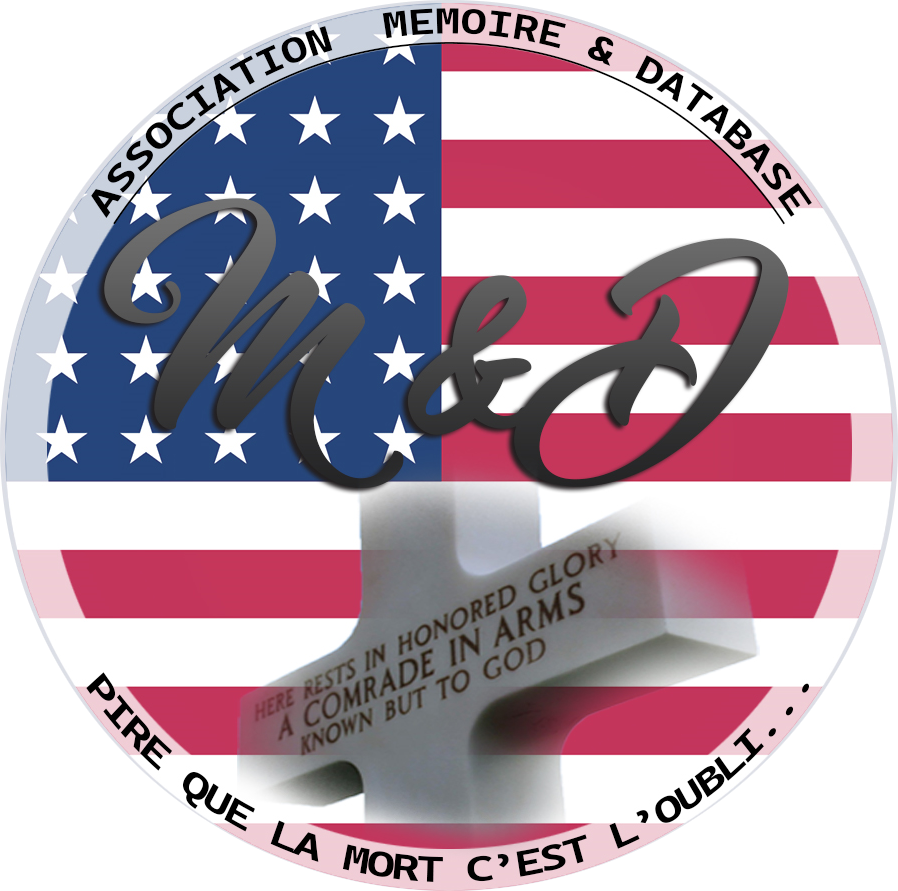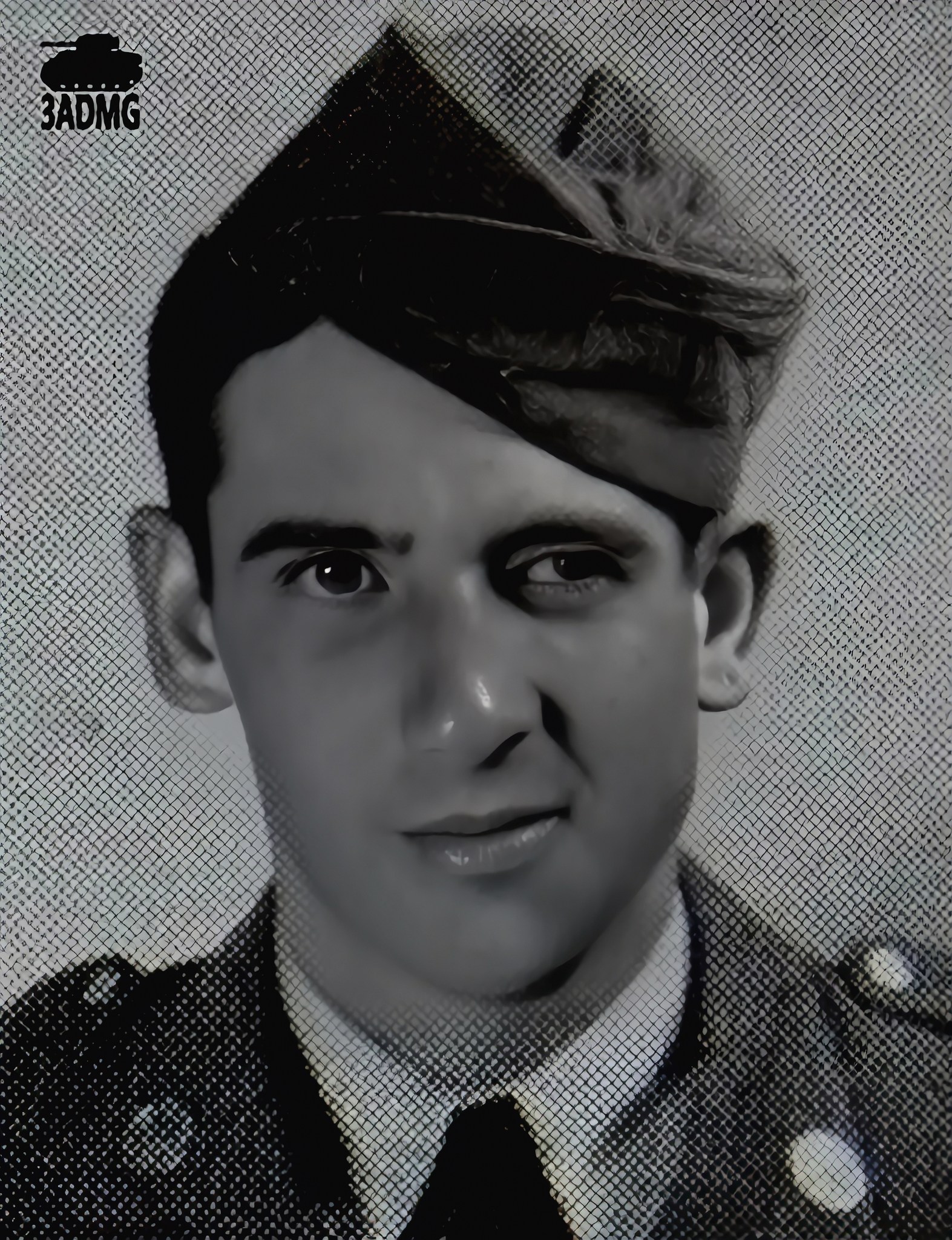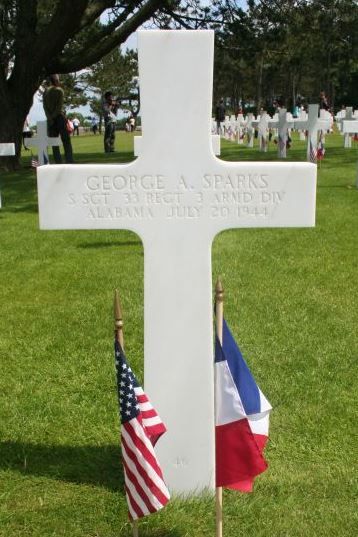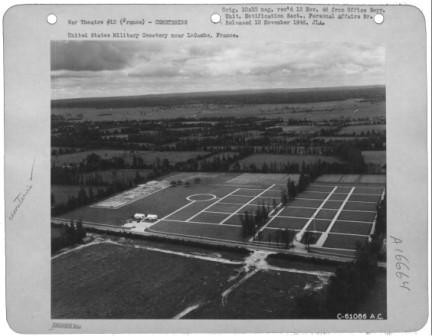|
George Arthur SPARKS
“Josh”
| ||||||||||||||||||||||||||
|---|---|---|---|---|---|---|---|---|---|---|---|---|---|---|---|---|---|---|---|---|---|---|---|---|---|---|
|
Source : Andy (Ellen Marchese) | ||||||||||||||||||||||||||
| NUMBER OF SERVICE | 06972348 | |||||||||||||||||||||||||
| AGE | 26 yo | |||||||||||||||||||||||||
| DATE OF BIRTH |
7 October 1917 Belgreen, Franklin County, ALABAMA | |||||||||||||||||||||||||
| ENLISTMENT STATE | ALABAMA | |||||||||||||||||||||||||
| FAMILY |
Parents : George Washington & Carrie Davis Sparks Siblings : Willie Lea , William Christoper & Dorothy Jean | |||||||||||||||||||||||||
| RANK |
| |||||||||||||||||||||||||
| FONCTION | Infantry | |||||||||||||||||||||||||
| JOB BEFORE ENLISTEMENT |  | |||||||||||||||||||||||||
| DATE of ENLISTEMENT | 5 October 1939 | |||||||||||||||||||||||||
| COMPANY | Company G | |||||||||||||||||||||||||
| REGIMENT | 33rd Armored Regiment | |||||||||||||||||||||||||
| DIVISION | 3rd Armored Division | |||||||||||||||||||||||||
| DATE OF DEATH | 26 July 1944 |
Source : Andy | ||||||||||||||||||||||||
| STATUS | KIA | |||||||||||||||||||||||||
| PLACE OF DEATH | Bois du Hommet, Pont-Hebert | |||||||||||||||||||||||||
| CEMETERY TEMPORARY |
CEMETERY TEMPORARY of La Cambe N°3539
| |||||||||||||||||||||||||
| CEMETERY | NORMANDY AMERICAN CEMETERY of Colleville | |||||||||||||||||||||||||
| GRAVE |
| |||||||||||||||||||||||||
| DECORATION |
| |||||||||||||||||||||||||
| ||||||||||||||||||||||||||
| STORY | ||||||||||||||||||||||||||
|
Source : William Kuner Remembering and Honoring this Soldier of World War II and his supreme sacrifice for his Country
| ||||||||||||||||||||||||||
Activated/Activé |
Normandy/Normandie |
| 15 Apr 1941 | Days of Combat/Jour de Combat 231 |
| Casualties/Victimes 9 243 | |
Entered Combat/Entré au combat |
|
| 9 Jul 1944 at Normandy | |
|
Commanding Generals/Commandants généraux Maj. Gen. Alvan C. Gillem (Apr 41 - Jan 42) |
Campaigns/CampagnesNormandy (6 Jun 44 - 24 Jul 44)
|
CAMPAIGN MAP OF THE EUROPEAN THEATER |
|
 |
|
DIVISION CHRONICLEThe 3d Armored Division landed in Normandy and entered combat 29 June 1944, taking part in the hedgerow fighting. The Division broke out at Marigny and with the 1st Infantry Division swung south to Mayenne in a general exploitation of the St. Lo break-through. In August 1944, the Division participated in the heavy fighting involved in closing the Falaise Gap, pocketing the German Seventh Army. Six days later (25 August) the Division had cut across the Seine River, and was streaking through Meaux, Soissons, Laon, Mons, Namur, and Liege. Liege fell 8 September and Eupen on 11 September. The Division breached the Siegfried Line with the capture of Rotgen, 12 September, and continued a slow advance against heavy resistance, to the vicinity of Langerwehe. When the Battle of the Bulge broke, the Division was shifted to Houffalize, Belgium, where it severed a vital highway leading to St. Vith, and in January participated in the reduction of the German salient west of Houffalize. After a brief rest, the Division returned to the front, crossed the Roer River- into Duren, broke out of the Duren bridgehead, and drove on to capture Koln, 6 March 45. The Division swept on to Paderborn ; it was at a road junction near Paderborn that Major General Rose was killed while attempting to surrender to a German tank commander, 31 March 1945. The Division took Paderborn, assisted in mopping up the Ruhr pocket, crossed the Saale River, and after overcoming stiff resistance took Dessau, 21-23 April 1945. |
CHRONIQUE DE DIVISIONLa 3ème division blindée débarqua en Normandie et entra au combat le 29 juin 1944, participant aux combats de haies. La division éclate à Marigny et la 1ère division d'infanterie se tourne vers le sud en direction de Mayenne pour une exploitation générale de la percée de St. Lo. En août 1944, la division participa aux combats acharnés liés à la fermeture du fossé de Falaise, empochant la septième armée allemande. Six jours plus tard (25 août), la division avait traversé la Seine et traversait Meaux, Soissons, Laon, Mons, Namur et Liège. Liège est tombé le 8 septembre et Eupen le 11 septembre. La division a franchi la ligne Siegfried avec la prise de Rotgen, le 12 septembre, et a continué sa progression lente contre une résistance importante, à proximité de Langerwehe. Lorsque la bataille des Ardennes a éclaté, la division s'est déplacée vers Houffalize, en Belgique, où elle a coupé une autoroute vitale menant à Saint-Vith, et a participé en janvier à la réduction du saillant allemand à l'ouest d'Houffalize. Après un bref repos, la division revint au front, traversa la rivière Roer jusqu'à Duren, sortit de la tête de pont de Duren et continua à capturer Cologne, le 6 mars 45. La division se dirigea vers Paderborn; C'est à un carrefour près de Paderborn que le général de division Rose a été tué alors qu'il tentait de se rendre à un commandant de char allemand, le 31 mars 1945. La division a pris Paderborn, a aidé à nettoyer la poche de la Ruhr, a traversé la Saale la résistance a pris Dessau, 21-23 avril 1945. |
| SOURCE INFORMATION & PHOTO | Armydivs.squarespace.com |
|---|
| SOURCE INFORMATION & SOURCE PHOTO | William Kuner - Abmc.gov - Findagrave.com - Aad.archives.gov - Henri Register - 36air-ad.com |
|---|---|
| EDITORS | Victor, Jean-Philippe, Eric, Henri, Garrett, Clive, Frédéric & Renaud |





























